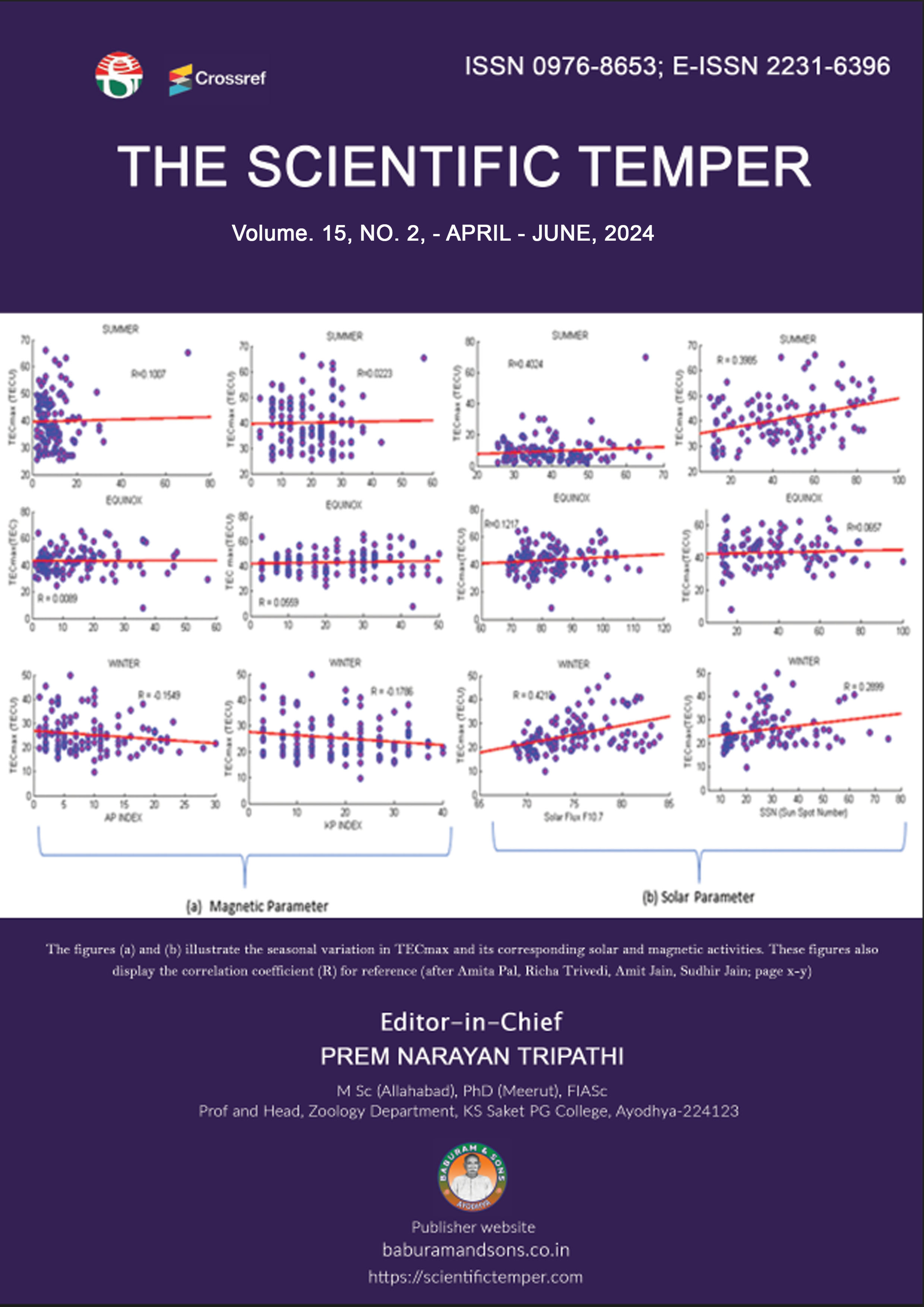Evaluation of white seeded sesame (Sesamum indicium L.) genotypes on growth and yield performance in Menit Goldya Woreda of West Omo Zone, SWE
Downloads
Published
DOI:
https://doi.org/10.58414/SCIENTIFICTEMPER.2024.15.2.46Keywords:
cropping seasons Genotypes (varieties), Location, sesame, yield, yield componentsDimensions Badge
Issue
Section
License
Copyright (c) 2024 The Scientific Temper

This work is licensed under a Creative Commons Attribution-NonCommercial-ShareAlike 4.0 International License.
Sesame is the second export crop next to coffee in annual export, indicating the highest 14% of the total world export of the crop. In Africa, Sudan is the major sesame producer, followed by Nigeria, Somalia, Uganda and Ethiopia. But lack of well-adapted varieties are one of the bottleneck production problems that account for low yield and small areas cropped to the nation. Thus it is essential to evaluate such genotypes, which have high yield potential and are suitable to local environmental conditions. Therefore, field experiments were conducted at west Omo zone during 2019/20 main cropping seasons at one location of West- the Omo zone, southwest Ethiopia. The location was Menit Goldiya districts of West Omo Zone, through evaluation and selection of high-yielding sesame varieties. The study comprised of five improved and one local sesame varieties laid out in RCBD with three replications at each location. The growth and yield data were collected and analyzed by using SAS Version 9.3 statistical software. The result of the study revealed that all of the parameters considered were significantly (p < 0.01) affected by varieties on both years. Accordingly, at Menit Goldiya for, all parameters in both years and the combined analysis over the years indicated that maximum plant height, number of primary branches per plant, number of capsules per plant, thousand seed weights in grams and seed yield were observed for the Humera-1 variety. Likewise, the shortest days to flowering, early maturing, the highest length of capsule bearing zone, the maximum number of capsules per plant, the highest number of seeds per capsule and the maximum seed yield (8.13 Qu/ha) were observed for the Humera-1 variety in 2019/2020 growing seasons. Based on the mean total seed yield of locations and different yield evaluation methods, a high-yielding variety was identified. Accordingly, the Humera-1 variety performed best on both years. Therefore, this variety can play a vital role in food self-sufficiency and food security of the south-western region and it should be widely distributed to farmers of the testing locations and similar areas of the region.Abstract
How to Cite
Downloads
Similar Articles
- Sadanand Maurya, Manikant Tripathi, Karunesh Kumar Tiwari, Awadhesh Kumar Shukla, Analyses of water quality using different physico-chemical parameters: A study of Saryu river , The Scientific Temper: Vol. 14 No. 03 (2023): The Scientific Temper
- Abbasova Sona Jamal, Aliyev Sabit Shakir, Mahmudov Elmir Heydar, Museyibli Emin Bakir, Nadirkhanova Dilshat Adalat, Econometric analysis of grain yields (using the example of the Republic of Azerbaijan) , The Scientific Temper: Vol. 16 No. 02 (2025): The Scientific Temper
- Vatsal Parashar, Dimple Raina, Shweta Sahni, Molecular profiling and prevalence of hepatitis B virus (HBV) in clinical isolates and its importance , The Scientific Temper: Vol. 14 No. 02 (2023): The Scientific Temper
- R. Chandra, R. P. Singh, B. K. Prasad, Effect of Genotype and Explant on Shoot Regeneration in Brassica juncea , The Scientific Temper: Vol. 11 No. 1&2 (2020): The Scientific Temper
- Shriram N. Kargaonkar, Sushma Pradeep Chalke, Sunil Mahajan, Statistical Modeling of Consumer Preferences for Eco-friendly Digital Products: A Data-driven Approach Toward Sustainable Consumption in India , The Scientific Temper: Vol. 16 No. 10 (2025): The Scientific Temper
- SUVRA MANDAL, PRIYABRATA DASC, ASHES DAS, DHIRENDRA NATH MONDAL, ANINDITA GHOSH, DEBARATI MUKHERJEE, RAGHWENDRA MISHRA, ATANU BHATACHARYYA, MANOJ KAR, EVALUATION OF ANTIOXIDANT ACTIVITY OF THE POLYOXYGENATED XANTHONES FROM SWERTIA CHIRATA BUCH., HAM , The Scientific Temper: Vol. 2 No. 1&2 (2011): The Scientific Temper
- SHAHID SAMI SIDDIQUE, MOHD ARIF, RAM BABU, RASHID HUSSAIN, INTEGRATED MANAEMENT OF BRINJAL SHOOT AND FRUIT BORER, LEUCINODES ORBONALLIS GUEN. , The Scientific Temper: Vol. 2 No. 1&2 (2011): The Scientific Temper
- Anurag Tripathi, Shri Prakash, Prem Narayan Tripathi, Impact of SARS-CoV-2 (COVID-19) on the Nervous System: A Critical Review , The Scientific Temper: Vol. 11 No. 1&2 (2020): The Scientific Temper
- Anupam Sinha, Rhizome Rot Disease of Ginger (Zingiber officinale Rosc.) and its Bio-control Strategy , The Scientific Temper: Vol. 11 No. 1&2 (2020): The Scientific Temper
- Pratibha Baluni, Pankaj Bahuguna, Rajani ., Rajesh Rayal, Nikhil Singh Kahera, Periphyton Community Structure of the Spring-fed Foot-hill Stream Tamsa Nadi from Doon Valley, Uttarakhand, India , The Scientific Temper: Vol. 11 No. 1&2 (2020): The Scientific Temper
<< < 1 2 3 4 5 6 7 8 9 10 > >>
You may also start an advanced similarity search for this article.



